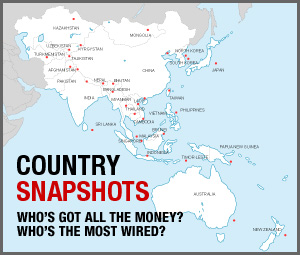
Water Security
image: Prakhar AmbaAs the economic success of many Asian nations is celebrated worldwide, the most fundamental resource for human survival–water–deserves immediate attention. In November 2008, the US National Intelligence Council Global Trends 2025 report highlighted the significance of water scarcity on the world’s largest continent as follows: ‘With water becoming more scarce in Asia and the Middle East, cooperation to manage changing water resources is likely to become more difficult within and between states.’
Scarcity as a result of land degradation is of great concern across Asia, but its linkage to food security is perhaps most acute in China and India. The secretariat of the UN Convention to Combat Desertification estimates that some 27 percent of China‘s land mass is desertified, with an average of 2,460 square kilometres of land being lost to advancing deserts each year. Nearly 400 million people live in these areas, and the economic loss to China has been estimated at around $6.5 billion a year. Central Asia is rich in water resources, but more than 90 percent of the water in this vast region is concentrated in Kyrgyzstan and Tajikistan.
Given such major disparities between countries, a regional approach to water security is essential and requires better and more secure diplomatic relations between countries of the continent.
With the support of the Asian Development Bank, an ‘Asia Pacific Water Forum’ has been established that commissioned an Asian Water Development Outlook in 2007. Such efforts are laudable but have limited influence on global institutions because they are often perceived as background technocratic documents rather than as clear policy prescriptive materials. In order to have a tangible impact on the planning horizon for water-related security issues, it is essential for world leaders to be engaged at the highest level of security discourse. Riparian agreements that worked in the past, such as the Indus Waters Treaty, between India and Pakistan, are being tested as scarcity increases.
Although home to more than half of the human population, Asia has less fresh water–3,920 cubic meters per person–than any continent. Almost two-thirds of global population growth is occurring in Asia, which is expected to grow by nearly 500 million within the next 10 years, mostly in urban areas. Asia’s rural population will remain almost stationary between now and 2025, but the urban population is likely to increase by 60 percent. The pressures on Asian water resources will be unprecedented and a clear strategy for dealing with these challenges is needed at multiple levels. Building infrastructure to harness water most efficiently should be a priority, but this must also be coupled with improving the governance regimes of existing water resources in rivers, lakes and aquifers. Creative diplomacy to manage these inherently trans-boundary resources must be proactively pursued to prevent adverse impacts on development indicators and a rise in regional conflicts.
Saleem H. Ali is associate professor of environmental planning at the University of Vermont. His most recent book is titled ‘Treasures of the Earth: Need, Greed and a Sustainable Future.’ (Yale University Press, 2009).











